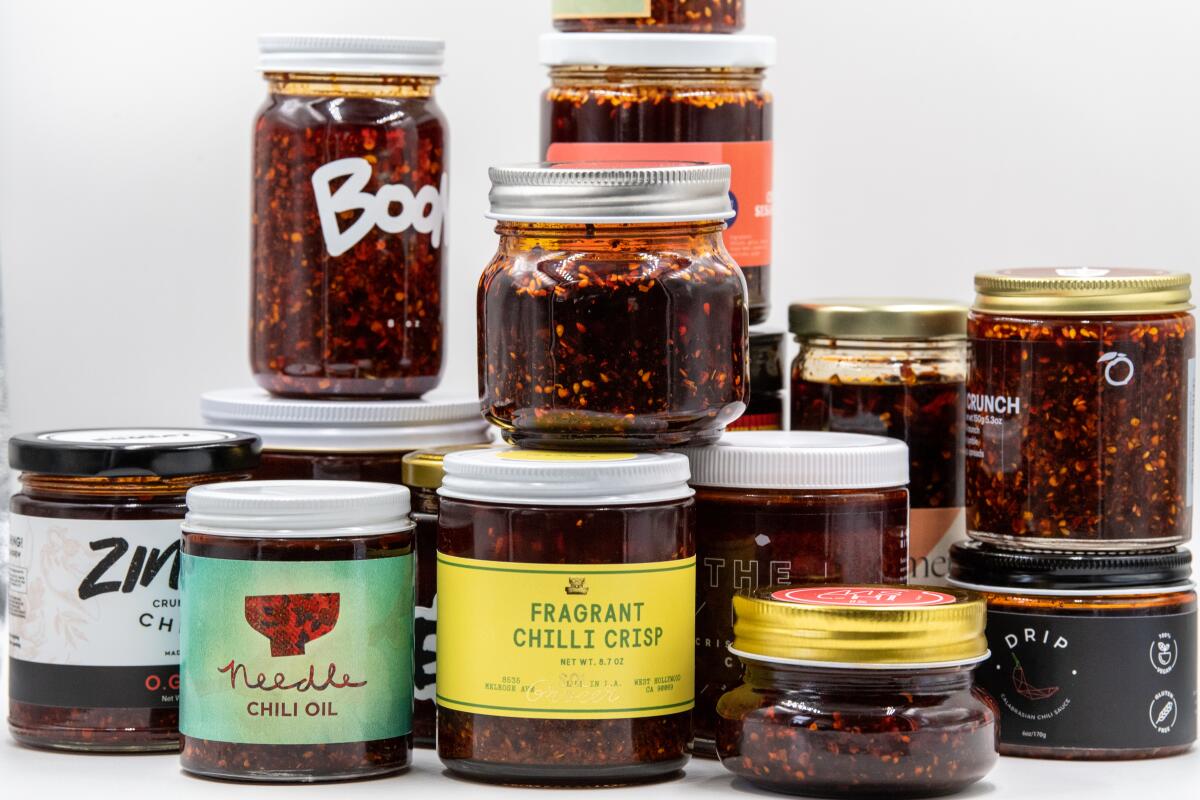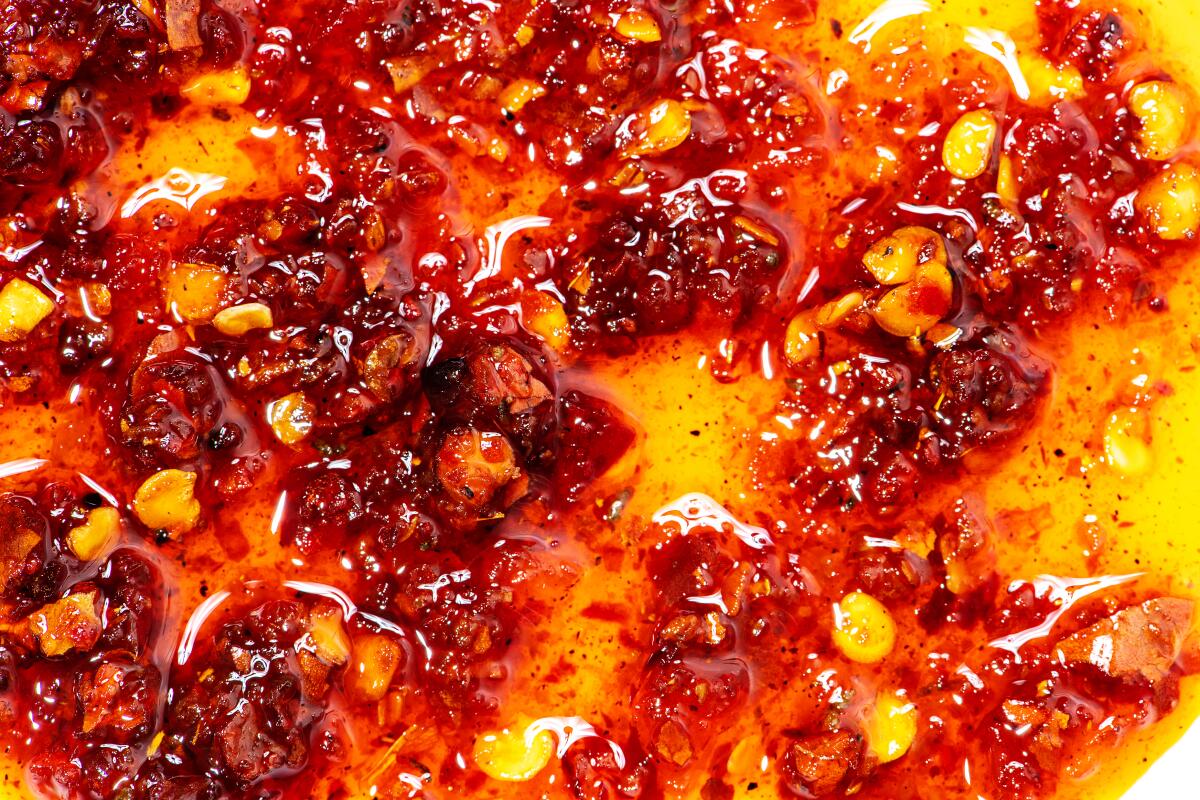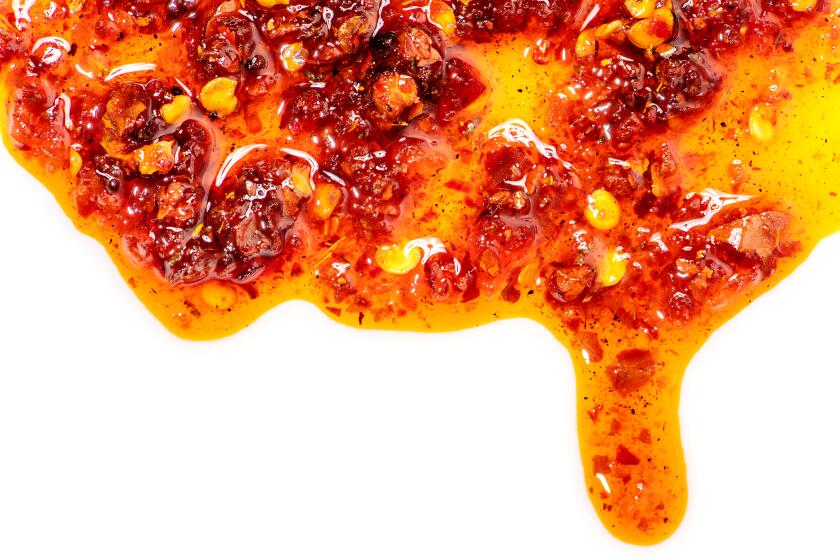Chili crisp capitalism meets a new wave of Asian American cynicism

- Share via
There was a time that I might have gotten excited and even emotional upon spotting a bottle of chili crisp in my local Trader Joe’s.
Now the millennial grocer has its own brand of fried alliums in chili oil, and I can’t get myself to buy it. Same for the boba currently on offer at Jack in the Box and Starbucks.
We’ve entered a strange new world of Asian American cultural capitalism. And judging by the way the Asian American community has roundly criticized chef David Chang’s recent attempt to trademark the term “chili crunch,” we’ve also reached a new era of Asian American cynicism.
Once an Asian American hot sauce entrepreneur might have been viewed as a heroic pioneer in a white-dominated space, bravely fighting to properly represent their culture. But do those feel-good narratives still apply, as those cultural pioneers age into corporations and institutions? Last month, Chang’s company, Momofuku, sent cease-and-desist letters to other businesses using the words “chili crunch,” a trademark his company recently acquired.
One of the targeted companies was MiLà, which counts Marvel actor Simu Liu among its investors. On X, Liu promptly challenged Chang to a chili crisp taste contest for which the winner gets the trademark. Though MiLà, which last year raised $22.5 million in an initial funding round, isn’t exactly a mom-and-pop shop either.
Jing Gao, chief executive of a competing company, Fly by Jing, publicly condemned Chang’s actions in a newsletter, arguing, rightfully, that Chang had tried to trademark “a descriptive term for a cultural product, one that has existed in Chinese cuisine for hundreds of years.” But Times columnist Jenn Harris found that Fly by Jing, which recently had a $12-million funding round, had sought its own trademarks for the terms “Sichuan chili crisp” and “Chengdu crunch.”
Momofuku wants ‘chili crunch.’ Fly by Jing wanted ‘Sichuan chili crisp.’ Why they shouldn’t have it.
To address the backlash, Chang released a podcast episode in which he explains that trademark law demands that holders of trademarks defend their rights in order to maintain ownership of them, and that the letters were Momofuku’s attempt to comply with that law. He pledged to stop enforcing the trademark, and Gao has also since decided to stop seeking their trademarks.
These steps suggest that Chang and Gao value their Asian American critics and their feedback. It’s important that Asian American entrepreneurs show that they care about Asian American customers. But the heat probably won’t die down completely. Cynicism about chili crisps predates this recent trademark dispute.
The market has expanded dramatically since the Chinese company Lao Gan Ma introduced its sauce in the 1980s. Chili crisps are now as popular on restaurant menus as sriracha hot sauce once was. A casual search online found more than 40 chili crisp brands, some of them by Asian American entrepreneurs but also products by Williams Sonoma, World Market and even one by this newspaper’s Food section. TikTokers recommend mixing it with butter, frying eggs with it, flavoring potato chips and even as an adventurous ice cream topping. It’s become the one Asian food product you are most likely to find outside an Asian neighborhood.
When an aspect of your culture becomes ubiquitous in the mainstream, no matter who you are, I think it’s natural to feel a little possessiveness. But I’ll probably never find a chili crisp with a brand story that perfectly represents my politics and identity, and I don’t expect to. Sometimes a jar of chili crisp is just that. Trying to define your cultural identity through your chili crisp consumption choices leads you to strange places.
On social media, some Asian Americans pledged their support for what they saw as the original, authentic chili crisp, the product by Lao Gan Ma. But a firm with a $1.7-billion valuation doesn’t really need anyone’s support, least of all that of Asian Americans.
“At the end of the day people are just projecting insecurities about Asian identities onto these issues,” said chef Johnny Lee, who might have started his own sauce company based on the recipe for his wildly popular Hainan chicken dish, if only ginger wasn’t so expensive and time-consuming to peel.
You can find a jar of chili oil on the tables at countless restaurants and noodle shops in the San Gabriel Valley, but in the last two years, Los Angeles has experienced a chile sauce revolution.
Lee ended his restaurant Pearl River Deli last year after he could not make the business model work. He wishes Asian American consumers, who demand the most and want to pay the least, weren’t so tough on Asian American entrepreneurs. If there was more solidarity between consumer and producer, maybe more of everyone’s favorite restaurants would still be open, Lee said.
“I think it’s this crabs-in-a-barrel mentality. If we have to compete with each other, we forget that there’s more of them than us,” Lee said.
But some cynicism is overdue. It’s been a decade since Michael Brown’s death in Ferguson, Mo., sparked a new generation of conversations about race and identity. These conversations have reshaped Hollywood, spurred reforms in policing and policy, and inspired a generation of Asian Americans to start telling their own stories. They’ve also begun to ring hollow.

Here I should admit that I’m uniquely primed for this cynicism, with an email inbox ever full of pitches with well-trod Asian American narratives. But I can listen to only so many stories of stinky lunch-box woe with a generous heart. There’s a persistent myopia in our cultural conversations, and perhaps that’s why I’ve noticed fewer Asian Americans engaging. Who wants to participate in a conversation where everyone is just talking about themselves?
Each year the fanfare for Asian American and Pacific Islander Heritage Month seems to grow more elaborate. But what are we celebrating? Asian American professionals are experiencing historic prosperity and wealth, but Asian American communities are ground away by gentrification. We tell upbeat stories in public and talk behind our hands when speaking hard truths. Celebrating AAPI Heritage Month each May, for me, is starting to feel like a forced smile.
The backlash to Momofuku’s trademark dispute at least shows that we are starting to define what solidarity with other Asian Americans means, even if all we have learned is that Asian American entrepreneurs should not sue one another for control of Asian American cultural products.
It is not any business’s job to perfectly represent the Asian American community. But it’s important that the creators of the pagoda lunch box, the thank-you bag, and the pink doughnut box did not try to capture all the profits that they created. Those businesses are worth celebrating — not for however many millions of egg rolls and fortune cookies they sold, but because these products made up a shared cultural franchise that allowed many different kinds of Asian immigrants to survive.
We celebrate their businesses because they didn’t forget the community in their quest for profits, and today’s Asian American capitalists should remember that.
More to Read
Sign up for Essential California
The most important California stories and recommendations in your inbox every morning.
You may occasionally receive promotional content from the Los Angeles Times.












